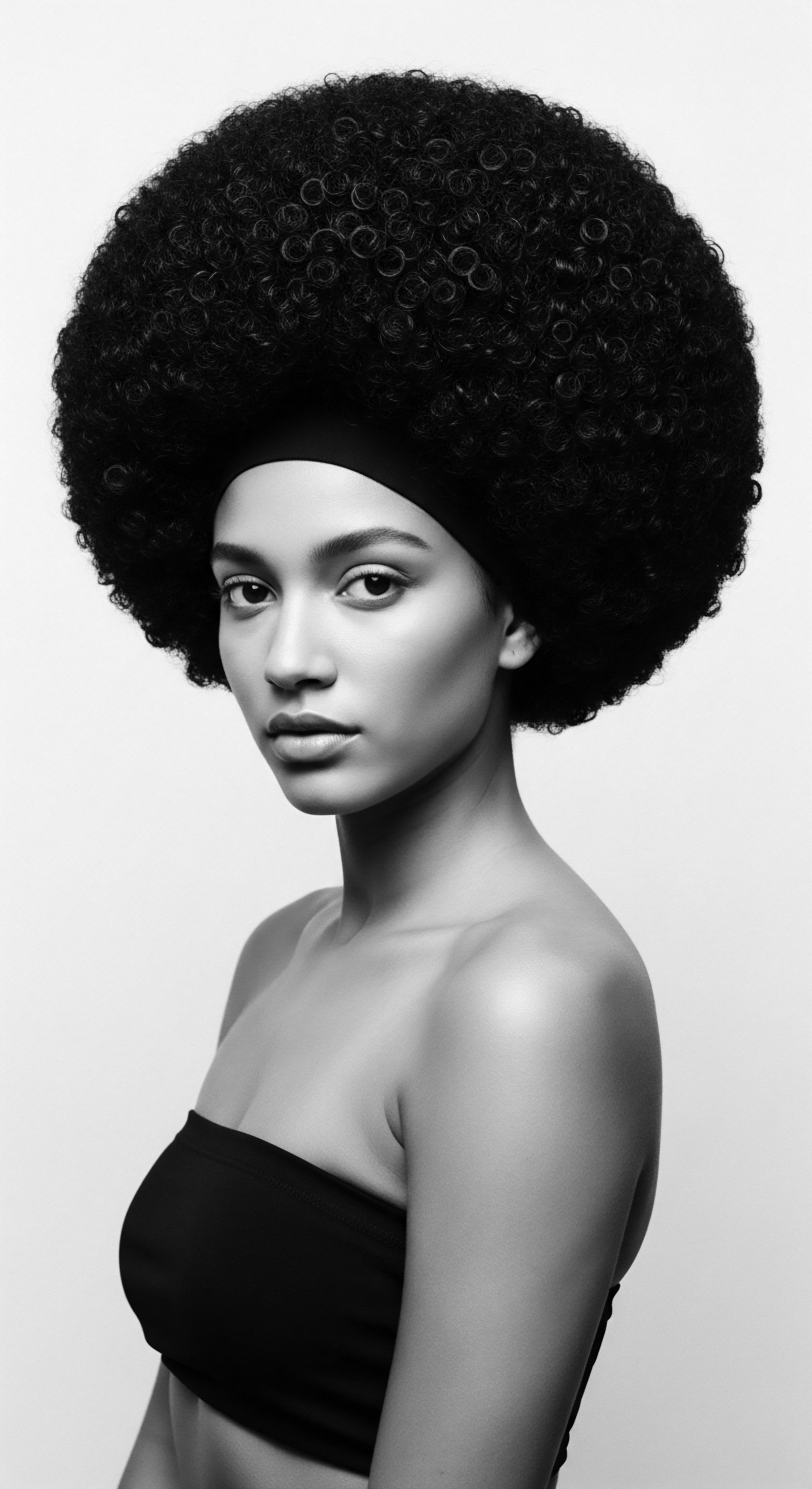
Fundamentals
The African Material Culture, at its simplest, represents the tangible objects, artifacts, and creations that peoples across the African continent have fashioned and utilized throughout history and into the present day. These items possess not just practical utility; they also carry profound spiritual, social, and aesthetic meanings. A woven basket from a village, an intricately carved stool from a royal court, or the very adornments worn on a head, each one tells a story. They are not merely static displays; they are living testaments to human ingenuity, cultural values, and the unbroken chain of ancestral wisdom.
These creations speak of a people’s relationship with their surroundings, their beliefs, their social structures, and their artistic inclinations. They are a reflection of shared heritage, passed down through generations, often adapting to new circumstances while retaining their essential spirit.
Consider the hands that shaped these objects. Those hands were guided by centuries of accumulated knowledge, by a deep reverence for the earth’s bounty, and by a knowing connection to community. When we consider African Material Culture, our gaze extends beyond the item itself, reaching into the human experience it embodies.
We recognize its power to convey identity, to celebrate life’s passages, and to preserve traditions. For those of us exploring textured hair, this connection becomes even more intimate, for hair itself has always served as a remarkable canvas for cultural expression across Africa and the diaspora.
African Material Culture encompasses tangible items imbued with deep spiritual, social, and aesthetic meaning, reflecting centuries of ancestral wisdom and ingenuity.
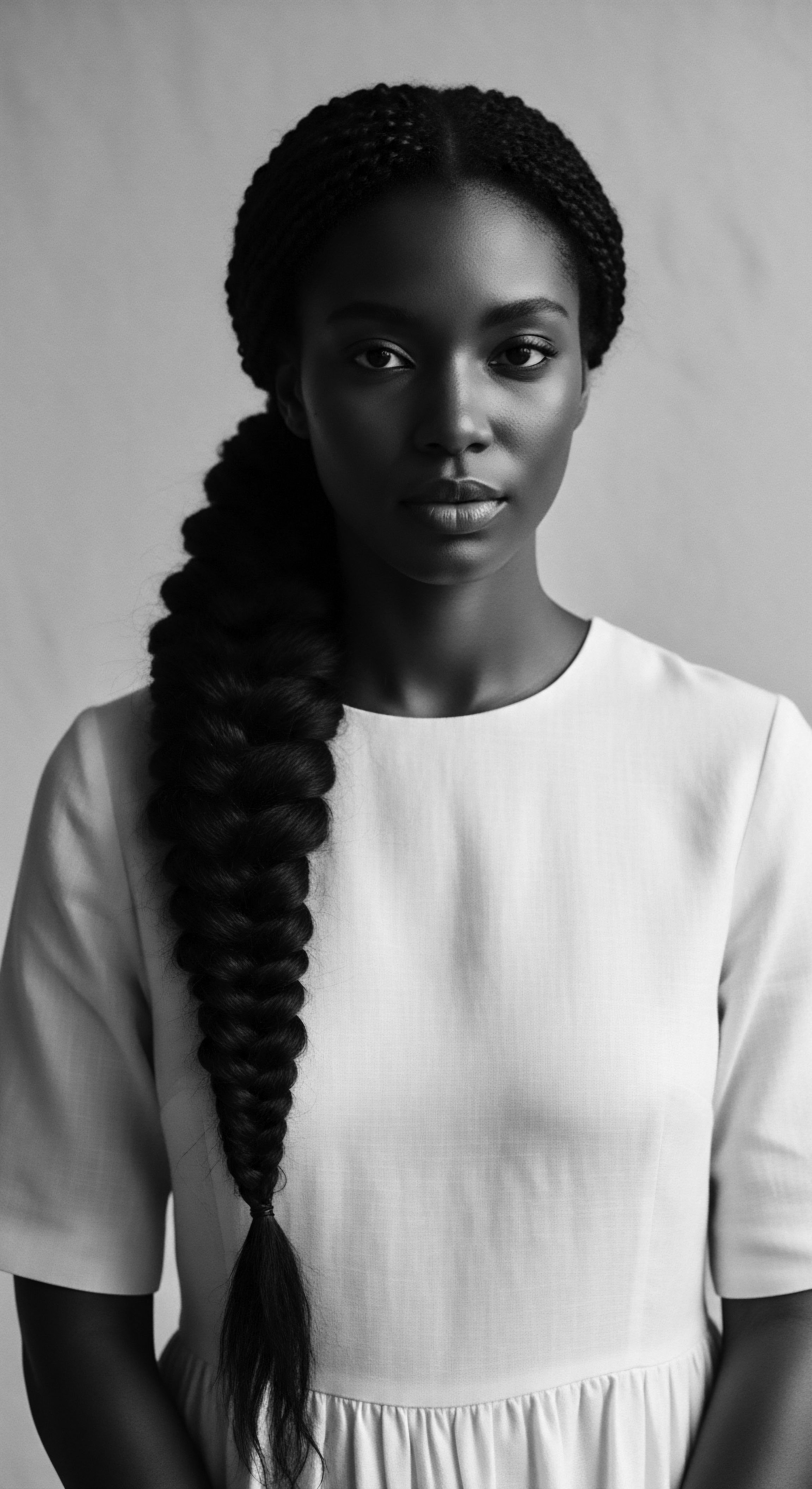
Echoes from the Source ❉ Hair as the Primary Canvas
In many African societies, hair is a sacred extension of the self, a conduit to ancestral realms, and a visible marker of one’s place in the world. It is, in its elemental biology, a fibrous protein structure, yet culturally, it transforms into an expressive medium. The practices surrounding hair, from styling to adornment, stand as a particularly vibrant aspect of African Material Culture. Tools, substances, and the very coiffures themselves become artifacts.
Hair serves as a dynamic form of communication, telling tales of age, marital status, social standing, religious affiliation, and tribal identity. The care rituals surrounding textured hair, often involving specialized tools and natural ingredients, have been refined over millennia, reflecting a profound comprehension of hair’s unique needs and its spiritual connections.
- Combs ❉ These were, and remain, vital implements for grooming textured hair. Early African combs, some dating back 5,500 to 7,000 years, show elaborate carvings, often depicting animals or human figures, serving as much as symbolic adornments as practical tools.
- Hair Extensions ❉ Dating back to ancient Egypt around 3400 BCE, hair extensions made from human hair, wool, and plant fibers were used not just for aesthetics but also for protection from the elements, symbolizing status and wealth.
- Natural Oils and Butters ❉ For generations, African communities have relied on indigenous botanicals like shea butter, coconut oil, and various plant extracts to moisturize, protect, and nourish hair, a practice deeply rooted in ethnobotanical wisdom.
These simple objects — a comb, a braid of fiber, a pot of butter — speak volumes about the heritage of care, the ingenuity of ancestors who understood the unique biology of textured hair, and the enduring human desire to express identity through physical form. Their continued presence, albeit sometimes in modernized forms, provides a comforting continuity, linking us directly to the wisdom of those who came before.
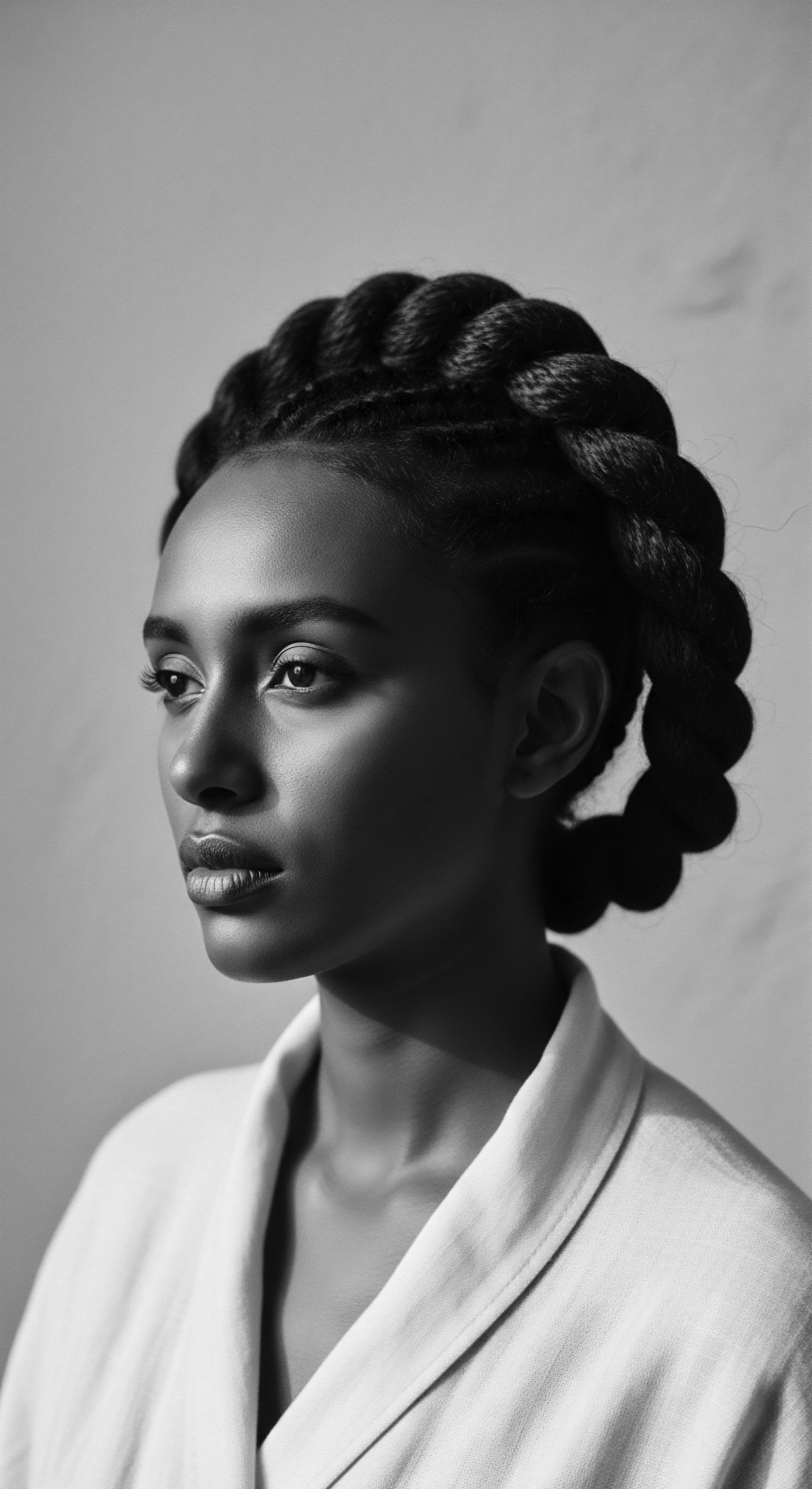
Intermediate
An intermediate grasp of African Material Culture extends beyond a mere listing of objects; it delves into the reciprocal relationship between people and their creations, particularly as these expressions relate to hair. It recognizes that these material forms are not simply passive reflections of culture. They are active agents in shaping identity, enacting social norms, and preserving collective memory.
The meaning of an object may shift across time or region, yet its fundamental connection to the lived experiences of African peoples remains constant. The cultural context provides the full sense of these artifacts.
The very concept of what constitutes “material culture” expands to include not only physical items but also the processes, skills, and communal rituals involved in their creation and use. Hair styling, as a profoundly communal and ritualistic practice, fits this expanded understanding perfectly. The hands that twist, braid, or adorn hair, the communal spaces where these practices unfold, and the oral histories shared during such sessions are all integral components of this living material heritage.
African Material Culture actively shapes identity and preserves collective memory, encompassing not just objects but also the practices and communal rituals of their creation and use.

The Tender Thread ❉ Living Traditions of Care and Community
The journey of textured hair care in African societies is a testament to adaptive brilliance. Before mass-produced items, communities relied solely on the gifts of their environment. This period saw the invention of diverse tools and the identification of potent natural ingredients, long before modern science articulated their benefits. This knowledge, often passed down through matriarchal lines, represents a profound scientific understanding grounded in observation and tradition.
Consider the art of hair braiding, a widespread practice across Africa. Cornrows, for instance, are an ancient braiding style, with depictions found dating back to 3500 BCE. These intricate patterns served as more than aesthetic choices; they functioned as a complex visual language. In some historical contexts, specific cornrow patterns could communicate marital status, age, or even a person’s tribal affiliation.
During the transatlantic slave trade, the practical and symbolic purpose of braids took on a deeper, more desperate meaning. Enslaved Africans, stripped of nearly everything, used cornrows to hide seeds for planting in the New World, ensuring survival and the continuation of their agricultural practices. There are also accounts suggesting specific braid patterns served as maps for escape routes along the Underground Railroad. This poignant historical example powerfully illuminates how African Material Culture, specifically hair styling, became a tool for survival, resistance, and the preservation of ancestral heritage in the face of unimaginable adversity.
The communal act of hair dressing also stands as a significant aspect of African Material Culture. It was often a social ritual, a time for bonding among family and friends, for storytelling, and for sharing wisdom across generations. This collective nurturing of hair, whether through braiding or oiling, reinforced social ties and transmitted cultural values. The tools used in these rituals—combs, pins, and razors, often crafted from wood, bone, or ivory—were not merely utilitarian; they were imbued with spiritual and social meaning, frequently adorned with figures or symbols reflecting beliefs about nature or status.
| Aspect of Hair Care Hair Moisturizing Agents |
| Historical Practices (Pre-Colonial Africa) Used natural oils, plant butters (e.g. shea butter), animal fats, and herbal preparations. |
| Contemporary Continuities/Adaptations Modern natural hair products often feature these traditional ingredients, emphasizing ancestral formulations for textured hair health. |
| Aspect of Hair Care Styling Tools |
| Historical Practices (Pre-Colonial Africa) Crafted combs, picks, and pins from wood, bone, ivory, and metal; hair threading techniques using natural fibers. |
| Contemporary Continuities/Adaptations Combs and picks continue as essential tools, often with modern materials; threading techniques persist in certain communities or are re-imagined in modern styles. |
| Aspect of Hair Care Hair Augmentation |
| Historical Practices (Pre-Colonial Africa) Utilized human hair, wool, plant fibers, and sinew for extensions and wigs, for protection, status, or aesthetics. |
| Contemporary Continuities/Adaptations Hair extensions and wigs remain popular, though often with synthetic materials; the cultural meaning of expression and protection remains. |
| Aspect of Hair Care Social/Ritualistic Function |
| Historical Practices (Pre-Colonial Africa) Hair styling served as a communal activity, a means of bonding, and a way to convey social, marital, and spiritual status. |
| Contemporary Continuities/Adaptations Hair salons and home styling sessions continue to be important social spaces, maintaining intergenerational connections and cultural expression. |

Regional Variations in Hair Traditions
The African continent is vast, home to countless distinct cultures, each with its own specific hair traditions that fall under the umbrella of African Material Culture. While common threads exist—the use of hair to communicate identity or the importance of communal styling—the forms these expressions take are wonderfully diverse.
- West African Hair Traditions ❉ The Fulani people, spread across countries like Niger, Mali, and Senegal, are renowned for their distinctive Fulani braids, often adorned with silver or gold coins, beads, and cowrie shells, signifying wealth, status, or marital state. In Nigeria, particularly among the Yoruba, hairstyles like Ìrun Dídì (cornrows) and Ìrun Kíkó (threaded styles) were deeply embedded in social and spiritual life, with specific styles reserved for different age groups, social classes, or ceremonial occasions. The very tools used, such as the ìlàrí or ìyàrí combs, were subject to specific regulations, reflecting the sacred nature of hair dressing.
- East African Hair Practices ❉ The Maasai people of East Africa held deep beliefs about hair and spiritual energy, considering the top of the head a point of entry for divine connection. Their practices, including specific hair shaving and re-growing rituals, symbolized life stages and spiritual reaffirmation. Elaborate braids crafted from animal hair also denoted wealth and status within the community.
- Central African Coiffures ❉ In the Congo, traditional hairstyles, particularly braids and spiral forms, distinguished different social groups among the Pygmies. The Mangbetu people of northeastern Congo were known for their elaborate coiffures that accentuated elongated skull shapes, a practice known as Lipombo. This remarkable practice, reflecting a distinct beauty ideal, involved wrapping infants’ heads to shape the skull, then styling the hair with natural materials, feathers, and beads to emphasize this form, transforming each hairstyle into a unique art piece. This demonstrates how the physical manipulation of the body, combined with hair artistry, becomes a powerful, living element of material culture, embodying cultural values and identity.
This geographical sweep provides only a glimpse into the richness of African hair traditions. Each region, each tribe, has stories held within its strands, stories that are preserved and transmitted through the continuous creation and maintenance of these deeply meaningful forms of material culture. The diversity speaks to an ancestral knowing, a wisdom that found profound ways to express identity through the very hair that springs from our crowns.

Academic
From an academic standpoint, African Material Culture extends beyond a simple definition of objects. It constitutes a complex field of inquiry within anthropology, archaeology, art history, and cultural studies, concerned with the nuanced interplay between human societies and the tangible items they produce, use, and interpret. This includes not only the physical properties and aesthetic qualities of an object but also its production methods, patterns of consumption, ceremonial functions, economic significance, and its capacity to embody and transmit belief systems across generations.
The meaning of African Material Culture is thus deeply contextual, dynamically shaped by its social, political, economic, and spiritual environments. Objects are not merely passive recipients of meaning; they are active participants in social life, capable of influencing behavior, signifying power, and mediating relationships within a community.
To properly define African Material Culture in an academic sense requires acknowledging its temporal depth and geographical breadth. From ancient civilizations like those in Egypt and Kush to contemporary urban centers, material forms have served as continuous markers of identity and expressions of agency. This academic lens requires a systematic approach to understanding how specific items, especially those related to hair, have been integrated into the daily routines, rites of passage, and broader ideological frameworks of African societies.
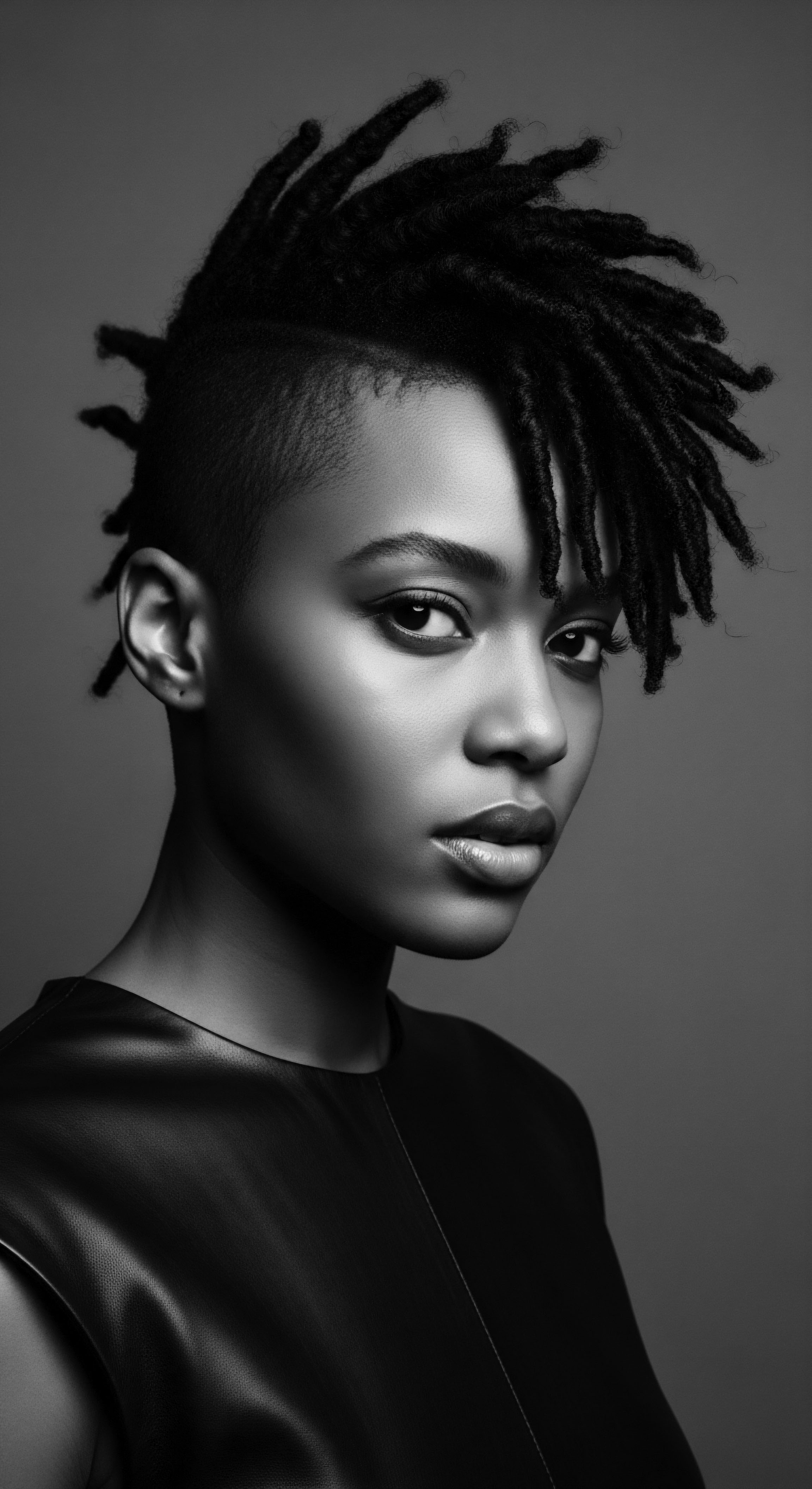
The Unbound Helix ❉ Hair as an Academic Case Study in Material Culture
The examination of textured hair within the discourse of African Material Culture reveals a compelling interplay between biological inheritance, aesthetic preference, and sociopolitical commentary. Hair, as a biological outgrowth, becomes a profound medium for cultural inscription, a site where individual identity, community affiliation, and ancestral lineage are publicly declared. This transformation of biological reality into cultural artifact provides fertile ground for academic inquiry, particularly when examining the practices surrounding Black and mixed-race hair experiences.
One particularly striking historical example that powerfully illuminates the African Material Culture’s connection to textured hair heritage and ancestral practices is the traditional practice of Lipombo among the Mangbetu People of northeastern Congo. This practice involved the gradual elongation of the skull from infancy, achieved by tightly wrapping a baby’s head with cloth. The resulting elongated cranial shape was considered a mark of beauty, intelligence, and high social standing among the Mangbetu ruling classes. This physical alteration of the body, a form of material culture itself, was then accentuated by elaborate hair styling.
The hair was meticulously styled upwards, often using natural materials, feathers, and beads to enhance the elongated silhouette of the head. This practice, outlawed by the Belgian government in the mid-20th century, presents a rigorous case study of how material culture extended beyond external adornment to the intentional shaping of the body itself, fundamentally altering and expressing deeply embedded cultural values. It underscores how the body, and specifically the head, became a canvas for ancestral practices, linking physical form to societal prestige and aesthetic ideals. The elaborate hairstyles were not merely decorative; they were the capstone of a bodily modification process that served as a visual testament to identity and status within the Mangbetu community.
The significance of hair styling as a form of material culture also extends to its symbolic resistance. During the transatlantic slave trade, the forced shaving of Africans’ heads was a dehumanizing act, intended to strip away their cultural connections and identities. Yet, even in such brutal conditions, African individuals adapted. They innovated with limited tools, using what was available—bacon grease, butter, kerosene as conditioners; cornmeal as dry shampoo; sheep fleece carding tools as combs.
This resourcefulness demonstrates the adaptive nature of African material culture, where survival and cultural preservation found expression even through the most challenging circumstances. The ability to create new forms of material culture from adverse conditions speaks to an enduring resilience and a deep-seated commitment to maintaining heritage.
Academic examination of African Material Culture reveals how hair transforms from a biological feature into a medium for cultural inscription, reflecting identity, community, and ancestral lineage.
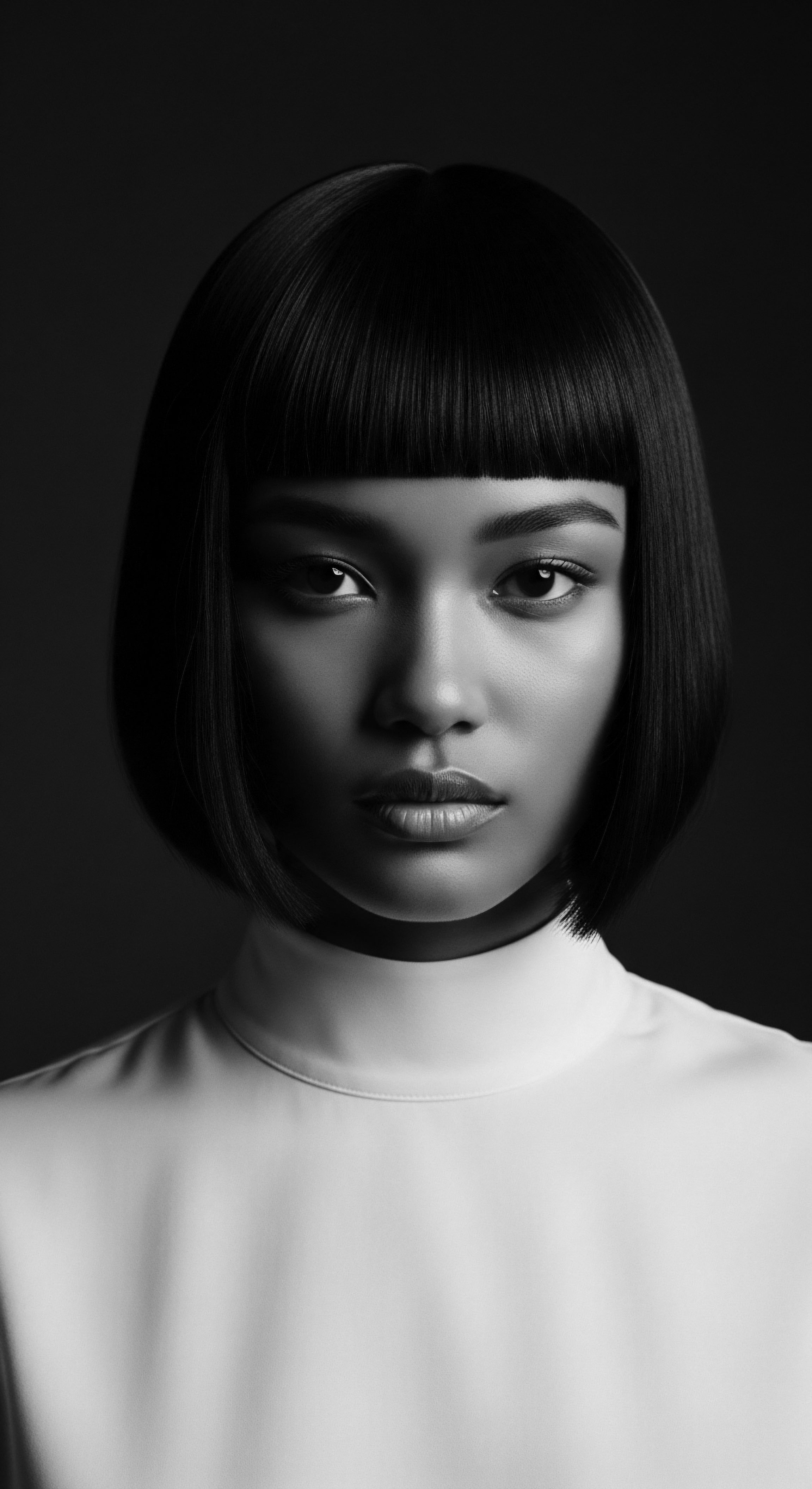
Tools and Technologies of Adornment
The material culture surrounding African hair is vast and diverse, encompassing a rich history of specialized tools and adornments. These objects, often crafted with remarkable artistry, served both practical and symbolic purposes.
- Combs and Picks ❉ The earliest African combs, discovered in regions that are now Sudan, South Sudan, and Egypt, date back an astonishing 7,000 years. These long-toothed implements, sometimes adorned with depictions of birds, bull horns, or hippopotamuses, reflect a reverence for nature and held cultural and animist significance. The function of these combs was not solely for detangling; they became emblems of status, group affiliation, and religious beliefs, with handles often decorated to reflect political or cultural references. The continuity of the Afro comb, particularly with its “black fist” motif popularized in the 1960s, demonstrates a powerful connection to the Black Power movement and a collective expression of pride and resistance against conforming to European beauty standards.
- Hairpins and Ornaments ❉ Ancient Egyptians utilized hairpins made from materials like bone, ivory, wood, and even precious metals such as gold, silver, and bronze, dating back to around 4000 BCE. These pins secured elaborate hairstyles and could also be decorative, sometimes protruding from the hair mass to display their terminals. For many African peoples, hair adornments like hats, pins, and combs conveyed beauty, authority, or social standing. Beads, cowrie shells, and gold were commonly integrated into braided styles, signifying wealth, marital status, or spiritual protection.
- Textiles and Extensions ❉ Beyond direct hair adornments, textiles and hair extensions represent another significant facet of African Material Culture. Early hair extensions in Africa, dating back to ancient Egypt, used natural materials like wool, grass, flax, and even sinew, to create length, volume, and intricate styles. The Mbalantu women of Namibia, for instance, were known for ankle-length braids achieved with sinew extensions, a testament to their creativity and cultural identity. Textiles themselves, crafted from wool, animal hair, cotton, and raffia, were historically used for clothing and as currency, often incorporating intricate designs, embroidery, and beadwork. These textile traditions frequently intersected with hair practices through headwraps and hair coverings, which also communicated social status, protection, and cultural adherence.

The Science of Ancestral Care
From a scientific lens, the ancestral knowledge embedded in African hair care practices demonstrates a sophisticated understanding of elemental biology and cosmetic chemistry, long before these terms were formalized. Traditional African methods often centered on moisturizing and protecting textured hair, recognizing its unique structural properties and susceptibility to dryness.
For instance, the widespread use of natural oils and butters was a response to the biological needs of coily and kinky hair. These substances provided emollients that sealed in moisture, preventing breakage and promoting healthy hair growth. Research today continues to explore the ethnobotanical applications of African plants in hair treatment and care, with some studies focusing on plants used for hair growth, anti-dandruff properties, or even their potential connection to metabolic health.
While ethnobotanical studies on nutricosmetic plants for hair care in Africa are still emerging, they point to a long history of empirical observation and effective application of plant-based remedies. The application of heat, through methods like threading, which would stretch the hair and maintain length, also displayed an understanding of hair manipulation without relying on harsh chemicals.
| Material Culture Element Natural Oils & Butters (e.g. shea butter, coconut oil) |
| Traditional African Understanding (Historical Context) Used for moisture, shine, protection, and as spiritual offerings. Hair appearance linked to health and fertility. |
| Modern Scientific Corroboration/Explanation Provide lipids, fatty acids, and vitamins. Known to penetrate hair shaft, reduce protein loss, enhance moisture retention, and act as sealants for textured hair. |
| Material Culture Element Hair Threading (e.g. Yoruba Ìrun Kíkó) |
| Traditional African Understanding (Historical Context) A protective style for managing hair, promoting growth, and creating specific cultural forms. Helped stretch and lengthen hair without heat. |
| Modern Scientific Corroboration/Explanation A tension-based styling method that elongates curls without chemical relaxers or direct heat, minimizing heat damage and promoting length retention by reducing friction. |
| Material Culture Element Combs & Picks (Traditional designs) |
| Traditional African Understanding (Historical Context) Served as tools for detangling and styling, but also as symbols of status, affiliation, and religious beliefs, sometimes worn as adornments. |
| Modern Scientific Corroboration/Explanation The wide-toothed structure of traditional combs is ideal for detangling dense, coily hair with minimal breakage, preventing mechanical stress often caused by fine-toothed combs. |
| Material Culture Element Hair Adornments (Beads, shells, textiles) |
| Traditional African Understanding (Historical Context) Markers of social status, age, marital status, wealth, and spiritual connection. Served as a visual language. |
| Modern Scientific Corroboration/Explanation While primarily aesthetic, these additions can provide structural support to styles and visually communicate complex social data non-verbally within groups. |
The persistence of these material culture forms, from specific hair treatments to styling tools, speaks to a heritage of embodied knowledge. This knowledge, born from centuries of observation and communal practice, provided effective strategies for maintaining the health and vitality of textured hair, long before contemporary dermatology or trichology formally approached the subject. This deep, living connection to ancestral practices is a defining characteristic of African Material Culture as it relates to hair.
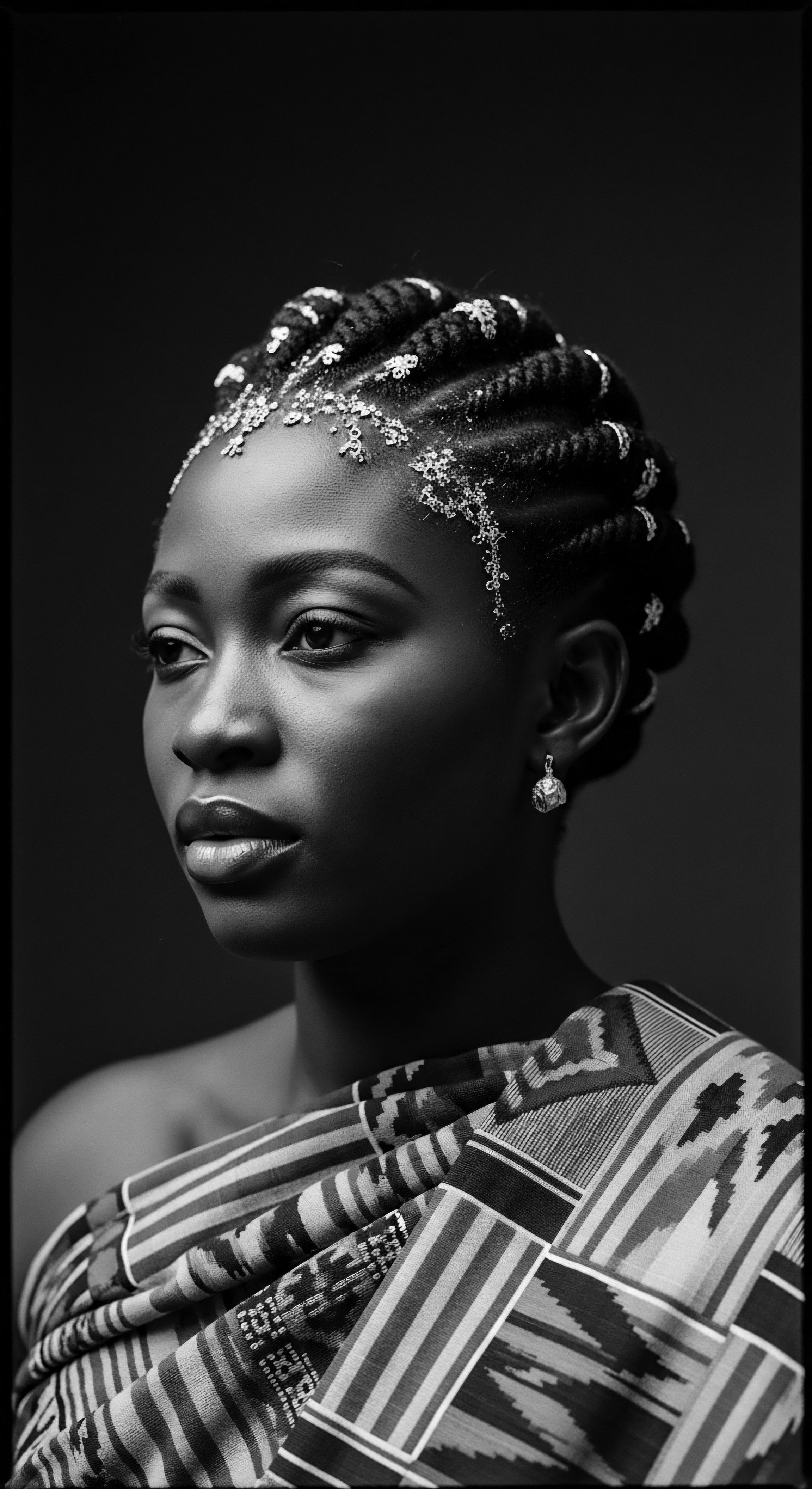
Reflection on the Heritage of African Material Culture
As we gaze upon the intricate braids, the adorned combs, or the very essence of well-cared-for textured hair, we are looking at more than mere objects or styles; we are witnessing the living legacy of African Material Culture. It is a heritage etched not only in artifacts but also in the very fibers of being, passed from elder to child, from hand to strand, across continents and generations. The journey of this material culture, from the earth’s elements to the adornments of the head, is a testament to the resilience, creativity, and enduring wisdom of African peoples.
The connection between African Material Culture and textured hair is a profound meditation on identity, survival, and celebration. It reminds us that our hair is a crown, a narrative, and a direct line to the ancestors who understood its spiritual weight, its social resonance, and its innate beauty. To care for textured hair with intention, drawing from these ancestral practices, is to honor a living heritage, to participate in a continuum of wisdom that strengthens our connection to self and to community. This awareness allows us to walk forward, rooted in the deep past, with our textured crowns speaking volumes of an unbound legacy.
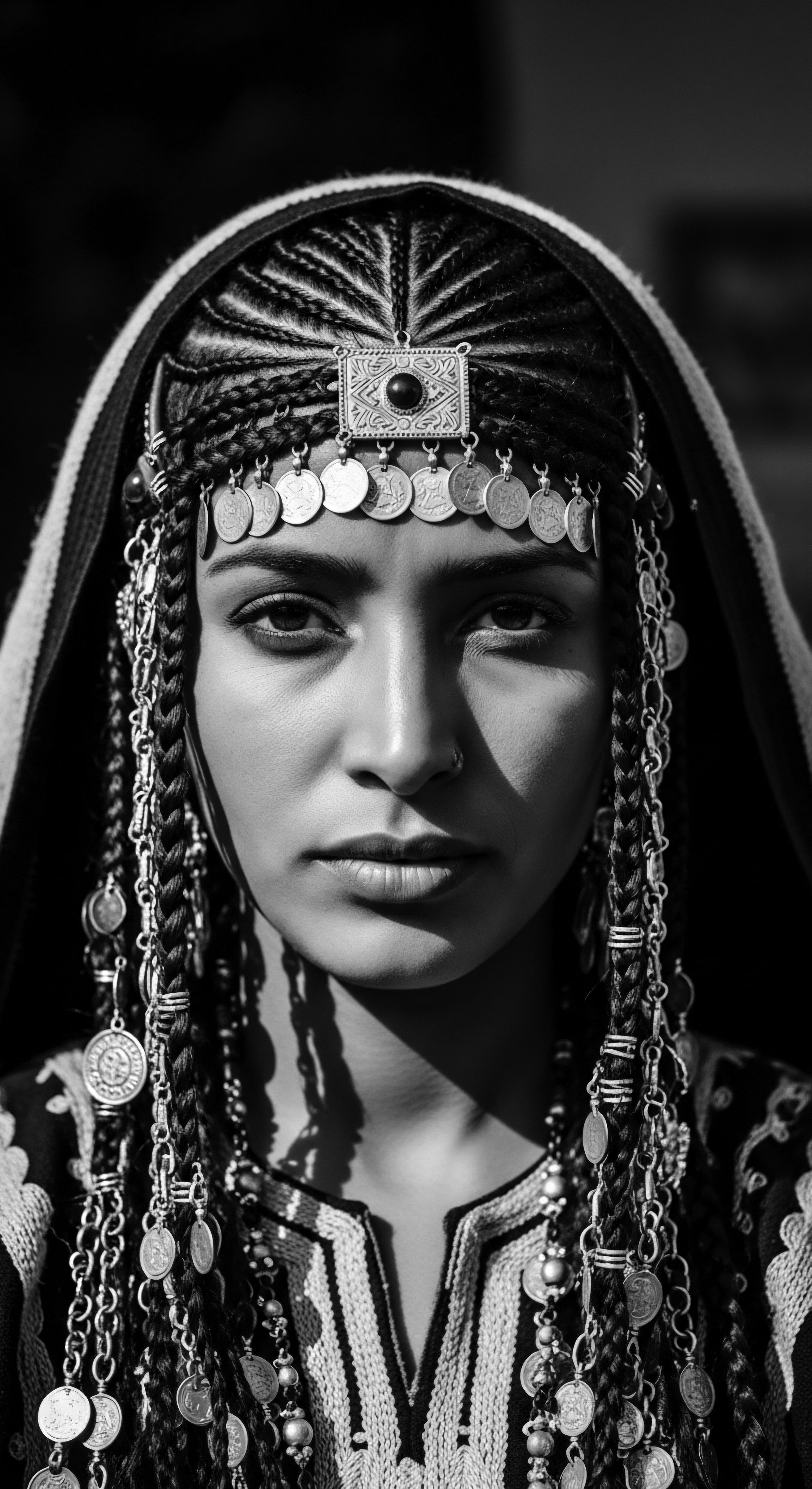
References
- Byrd, Ayana, and Lori L. Tharps. Hair Story ❉ Untangling the Roots of Black Hair in America. St. Martin’s Press, 2001.
- Arnoldi, Mary Jo, Christraud M. Geary, and Kris L. Hardin. African Material Culture. Indiana University Press, 1996.
- Antiri, J.A. “Akan combs.” African Arts 8, no. 1 (1974) ❉ 32-35.
- Ashton, S-A. “Ancient Egyptian Hair combs in the Fitzwilliam Museum, Cambridge.” In Aston, D. B. Bader, C. Gallorini, P. Nicholson, and S. Buckingham (eds.). Under the Potter’s Tree ❉ Studies on Ancient Egypt presented to Janine Bourriau. Peeters Publishers, 2004.
- Robins, Gay. “Hair, Gender, and Social Status in Ancient Egypt.” JSTOR Daily, 2020.
- Fletcher, Joann. “The Egyptian Hair Pin ❉ practical, sacred, fatal.” Internet Archaeology 42 (2016).
- Schildkrout, Enid, and Curtis A. Keim. African Reflections ❉ Art from Northeastern Zaire. University of Washington Press, 1990.
- Walker, Susan, and Morris Bierbrier. Ancient Faces ❉ Mummy Portraits from Roman Egypt. British Museum Press, 1997.
- Tharps, Lori L. and Ayana Byrd. Hair Story ❉ Untangling the Roots of Black Hair in America. St. Martin’s Press, 2014.
- Osorio, Alice. “What Every Dermatologist Must Know About the History of Black Hair.” Journal of Drugs in Dermatology 22, no. 11 (2023) ❉ 1060-1065.
